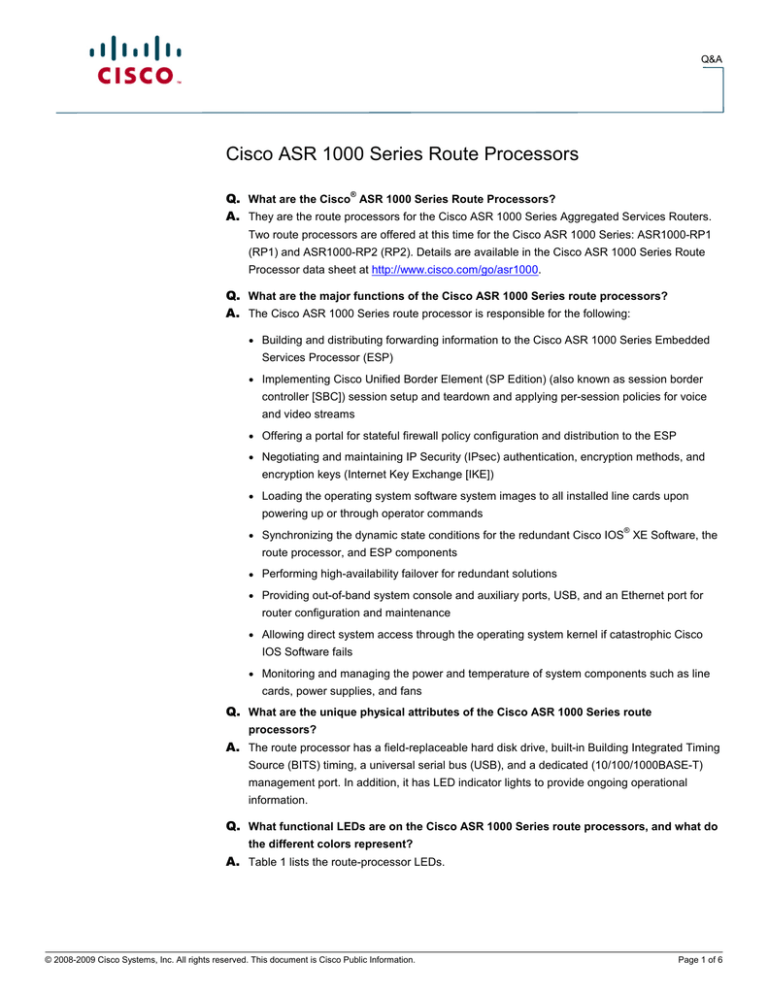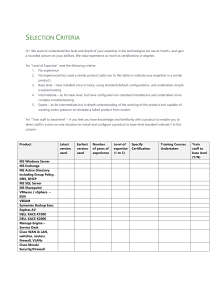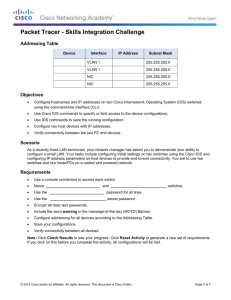
Q&A
Cisco ASR 1000 Series Route Processors
Q. What are the Cisco® ASR 1000 Series Route Processors?
A. They are the route processors for the Cisco ASR 1000 Series Aggregated Services Routers.
Two route processors are offered at this time for the Cisco ASR 1000 Series: ASR1000-RP1
(RP1) and ASR1000-RP2 (RP2). Details are available in the Cisco ASR 1000 Series Route
Processor data sheet at http://www.cisco.com/go/asr1000.
Q. What are the major functions of the Cisco ASR 1000 Series route processors?
A. The Cisco ASR 1000 Series route processor is responsible for the following:
●
Building and distributing forwarding information to the Cisco ASR 1000 Series Embedded
Services Processor (ESP)
●
Implementing Cisco Unified Border Element (SP Edition) (also known as session border
controller [SBC]) session setup and teardown and applying per-session policies for voice
and video streams
●
Offering a portal for stateful firewall policy configuration and distribution to the ESP
●
Negotiating and maintaining IP Security (IPsec) authentication, encryption methods, and
encryption keys (Internet Key Exchange [IKE])
●
Loading the operating system software system images to all installed line cards upon
powering up or through operator commands
●
®
Synchronizing the dynamic state conditions for the redundant Cisco IOS XE Software, the
route processor, and ESP components
●
Performing high-availability failover for redundant solutions
●
Providing out-of-band system console and auxiliary ports, USB, and an Ethernet port for
router configuration and maintenance
●
Allowing direct system access through the operating system kernel if catastrophic Cisco
IOS Software fails
●
Monitoring and managing the power and temperature of system components such as line
cards, power supplies, and fans
Q. What are the unique physical attributes of the Cisco ASR 1000 Series route
processors?
A. The route processor has a field-replaceable hard disk drive, built-in Building Integrated Timing
Source (BITS) timing, a universal serial bus (USB), and a dedicated (10/100/1000BASE-T)
management port. In addition, it has LED indicator lights to provide ongoing operational
information.
Q. What functional LEDs are on the Cisco ASR 1000 Series route processors, and what do
the different colors represent?
A. Table 1 lists the route-processor LEDs.
© 2008-2009 Cisco Systems, Inc. All rights reserved. This document is Cisco Public Information.
Page 1 of 6
Q&A
Table 1.
Cisco ASR 1000 Series RP1 LEDs
LED Function
Color or State
Meaning (Default = Off)
Green
Green if all power rails are within specification
Status
Green
Green when Cisco IOS® Software has booted
STAT
Yellow
Yellow when BootRom has successfully loaded
LABEL
Power
PWR
Red
Red indicates system failure
On @ power up; turned off by software
Active
Green
Lit when this is the active route processor
Yellow
Lit when this is the standby route processor
ACTV
Standby
STBY
Critical
Red
CRIT
Major
Critical alarm indicator
On @ power up; turned off by software
Red
Major alarm indicator
Amber
Minor alarm indicator
10/100/1000 RJ-45 interface
Solid green
Link with no activity
LINK
Flashing green
Link with activity
MAJ
Minor
MIN
Internal Compact Flash
(BootFlash)
BF
External USB Compact Flash
USB
Internal hard drive
HD
BITS interface
CARRIER
Off
No link
Flashing green
Activity indicator
Off
No activity
Flashing green
Activity indicator
Off
No activity
Flashing green
Activity indicator
Off
No activity
Off
Out of service or not configured
Green
In frame or working properly
Amber
Fault or loop condition
Q. Are routing protocols supported on the 10/100/1000BASE-T management interface?
A. Yes, routing protocols are supported on the management interface. However, the
management interface is strictly for management purposes only, with limited packet
forwarding.
Q. What timing sources does the Cisco ASR 1000 Series route processors support?
A. It can receive timing information through its BITS interface or through a time-division
multiplexing (TDM)-based Cisco ASR 1000 Series Shared Port Adapter (SPA).
© 2008-2009 Cisco Systems, Inc. All rights reserved. This document is Cisco Public Information.
Page 2 of 6
Q&A
Memory
Q. What are the DRAM memory options for the Cisco ASR 1000 Series RP1?
A. It uses two 1- or 2-GB double data rate 2 (DDR2) mini-dual in-line memory modules (DIMMs),
for a combined total of 2 or 4 GB. The part number to order the 4-GB DRAM as a fieldupgradable spare is M-ASR1K-RP1-4GB=. The Cisco ASR 1002 Router chassis has an
integrated RP1. The Cisco ASR 1002 Router comes in two versions. The Cisco ASR 1002
comes with 2-GB DRAM and the enhanced-memory Cisco ASR 1002-EM comes with 4-GB
DRAM.
Q. What are the DRAM memory options for the Cisco ASR 1000 Series RP2?
A. It uses four 2- or 4-GB synchronous dynamic RAM (SDRAM) for a combined total of 8 or 16
GB. The part number to order the 16-GB DRAM as a field-upgradable spare is M-ASR1KRP2-16GB=.
Q. What are the eUSB memory options for the Cisco ASR 1000 Series Route Processor?
A. The route processor can support a 1-GB eUSB module.
Software Support
Q. What Cisco IOS Software releases does the Cisco ASR 1000 Series Route Processor
support?
A. It runs the Cisco IOS XE Software, which is based on Cisco IOS Software Release 12.2SR.
Q. Are the command-line interface (CLI) commands for Cisco IOS XE Software the same as
those for other Cisco IOS Software releases?
A. Yes, Cisco IOS XE Software has the same user interface as standard Cisco IOS Software.
Q. What is the first Cisco IOS XE Software release for the Cisco ASR 1000 Series RP1?
A. Cisco IOS Software Release 2.1.0 is the first software release for the Cisco ASR 1000 Series
RP1.
Q. What is the first Cisco IOS XE Software release for the Cisco ASR 1000 Series RP2?
A. Cisco IOS Software Release 2.3.0 is the first software release for the Cisco ASR 1000 Series
RP2.
Q. What is the naming schema for the Cisco IOS XE Software?
A. The Cisco IOS XE Software uses the following naming schema:
X.Y.Z
Where: X = Major release
Y = Release version
Z = Rebuild
Hence, Release 1 is shown as 2.1.0, the first rebuild of Release 1 is 2.1.1, and the second
rebuild of Release 1 is 2.1.2.
Q. What is the release schedule for the Cisco IOS XE Software?
A. New release versions that will include new features will occur every 4 months. Each release
version will have two rebuilds that will address quality concerns and will contain no new
features. The first rebuild release will be made available 2 months after shipment of a release
version. The second rebuild release will be made available 4 months after shipment of the
© 2008-2009 Cisco Systems, Inc. All rights reserved. This document is Cisco Public Information.
Page 3 of 6
Q&A
same release version. Rebuilds to correct critical problems (such as those identified by the
Cisco Product Security Incident Response Team [PSIRT]) will be introduced as needed.
Q. What is a Cisco IOS XE Software consolidated image?
A. The Cisco IOS XE Software uses a modular software design consisting of seven software
modules. Each module facilitates functions for different components of the Cisco ASR 1000
Series Router platform. A single consolidated Cisco ASR 1000 software image file will contain
the seven individual modules.
Q. What are the Cisco IOS XE Software modules?
A. Table 2 lists the modules that comprise the Cisco IOS XE Software.
Table 2.
Cisco IOS XE Software Images
Image
Image Name
Purpose
RPBase
ASR1000rp<1 or 2>rpbase.<ASR_RELEASE>.<IOS_VERSION>.<IOS_RE
LEASE>.pkg
Provides the operating system software for the
route processor
RPControl
ASR1000rp<1 or 2>rpcontrol.<ASR_RELEASE>.<IOS_VERSION>.<IOS_R
ELEASE>.pkg
Controls the control-plane processes that
interface between Cisco IOS Software and the
rest of the platform
RPAccess
ASR1000rp<1 or 2>rpaccess.<ASR_RELEASE>.<IOS_VERSION>.<IOS_R
ELEASE>.pkg
(Software required for router access) Included
(non-K9 version) only in consolidated images
that do not have cryptographic support
ASR1000rp<1 or 2>rpaccessk9.<ASR_RELEASE>.<IOS_VERSION>.<IOS
_RELEASE>.pkg
(Software required for router access) Includes
(K9 version) restricted components (Secure
Sockets Layer [SSL], Secure Shell [SSH]
Protocol, and other security features);
consolidated images are subject to export
controls
RPIOS
Provides the Cisco IOS Software kernel, which
ASR1000rp<1 or 2>-rpiosipbase.<ASR_RELEASE>.<IOS_VERSION>.<IOS_REL is where Cisco IOS Software features are
stored and run; each consolidated image has a
EASE>.pkg
different RPIOS
ASR1000rp<1 or 2>-rpiosipbasek9.<ASR_RELEASE>.<IOS_VERSION>.<IOS_R
ELEASE>.pkg
ASR1000rp<1 or 2>-rpiosadvipservicesk9.<ASR_RELEASE>.<IOS_VERSION>.<
IOS_RELEASE>.pkg
ASR1000rp<1 or 2>-rpiosadventservicesk9.<ASR_RELEASE>.<IOS_VERSION>.
<IOS_RELEASE>.pkg
Provides the ESP operating system and control
processes, and the ESP software
ESPBase
ASR1000rp<1 or 2>espbase.<ASR_RELEASE>.<IOS_VERSION>.<IOS_R
ELEASE>.pkg
SIPSPA
Provides the SPA driver and associated fieldASR1000rp<1 or 2>sipspa.<ASR_RELEASE>.<IOS_VERSION>.<IOS_REL programmable device (FPD) images
EASE>.pkg
SIPBase
ASR1000rp<1 or 2>sipbase.<ASR_RELEASE>.<IOS_VERSION>.<IOS_RE
LEASE>.pkg
Controls the SIP carrier-card operating system
and control processes
Q. Why does booting individual Cisco IOS XE Software modules consume less memory
and boot faster than booting a consolidated image?
A. When a Cisco ASR 1000 Series Router is booted through individual modules, software image
content from the route processor is copied into memory on an as-needed basis, conserving
memory for other router processes and leading to more efficient booting.
© 2008-2009 Cisco Systems, Inc. All rights reserved. This document is Cisco Public Information.
Page 4 of 6
Q&A
Q. What are the advantages of booting a Cisco IOS XE Software consolidated image?
A. The advantages include ease of management and the ability to boot an image stored on a
network Trivial File Transfer Protocol (TFTP) server.
Q. What are the advantages of booting the Cisco IOS XE Software in individual module
mode?
A. The advantages of booting the system in individual module mode include faster booting,
route-processor memory efficiency, and In Service Software Upgrade (ISSU) support for the
Cisco IOS Software route processor for single Cisco ASR 1000 Series Route Processor
solutions.
Q. Can the router boot directly from Cisco IOS XE Software images stored in USB memory
keys?
A. Yes.
Q. What are the limitations from a router file system standpoint for booting the Cisco IOS
XE Software?
A. All image files must be kept in the same directory on the Cisco ASR 1000 Series Router hard
disk drive, embedded (EUSB), or bootflash. Booting image files stripped across file systems
and from USB memory keys is not supported.
Q. What are the requirements for ISSU on a single Cisco ASR 1000 Series route processor
system?
A. The requirements follow:
●
The Cisco ASR 1000 Series RP1 must have 4 GB of DRAM
◦
Note: The Cisco ASR 1002 Router comes in two versions. The version that supports 4GB DRAM is the Cisco ASR 1002-EM; the Cisco ASR 1002 supports 2-GB DRAM only
●
ISSU is supported only on RPControl, RPSecurity, and RPIOS images on single Cisco ASR
1000 Series Route Processor systems. You can perform an ISSU upgrade on the RPIOS
module on a single Cisco ASR 1000 Series route processor system only if the router was
originally booted with active/standby RPIOS processes
Q. When I issue the show memory command, the Cisco ASR 1000 Series route processor
is reporting less than 50 percent of the installed memory. Why isn’t the route processor
recognizing all of the installed memory?
A. On the Cisco ASR 1000 Series route processor, the show memory command is reporting only
the memory that has been allocated to the RPIOS process. The Cisco IOS XE Software
command show platform software memory provides a memory breakdown by platform
processes.
Q. Why does the Cisco IOS XE Software RPIOS process consume only so much or so little
memory?
A. The Cisco IOS XE Software RPIOS process is preallocated a fixed amount of memory upon
startup. The memory assigned to the RPIOS process never shrinks or grows, and is used to
manage both the routing and forwarding tables on the router.
Q. Can the router be configured to allocate more or less Cisco ASR 1000 Series route
processor memory to the RPIOS process?
A. No, RPIOS memory allocation is preallocated upon bootup and cannot be altered.
© 2008-2009 Cisco Systems, Inc. All rights reserved. This document is Cisco Public Information.
Page 5 of 6
Q&A
Q. Why do the Cisco IOS XE Software RPIOS processes consume less memory when
running in dual versus standalone mode?
A. The Cisco IOS XE Software reserves approximately 50 percent of the Cisco ASR 1000 RP1
memory for the RPIOS process(es). When running RPIOS in dual mode, the software
preallocates approximately 25 percent of the Cisco ASR 1000 route processor memory to
each RPIOS process.
Q. What are the scalability effects of running dual Cisco IOS XE Software processes?
A. When running dual Cisco IOS XE Software processes, the maximum routing table supported
is reduced by approximately 50 percent.
Q. Is High Availability supported on the Cisco ASR 1000 Series route processor?
A. The Cisco ASR 1000 Series RP1 with 4 GB and RP2 both support RPIOS High Availability.
Full RP hardware and software High Availability support is available only on Cisco ASR 1006
Routers between common route processor types. ASR1006 hardware and software HA is not
supported between RP1 and RP2 installed in the same system.
Printed in USA
© 2008-2009 Cisco Systems, Inc. All rights reserved. This document is Cisco Public Information.
C67-443169-03 07/09
Page 6 of 6



